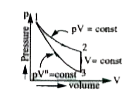0.2m3 of an ideal gas at a pressure of 2 Mpa and 600 K is expanded isothermally to 5 times the initial volume. It is then cooled to 300 K at constant volume and then compressed back polystro-pically to its initial state. Determine the work done and heat transfer during the cycle.
Considering process 1-2 which is isothermal, i.e., T1=T2=600K
P2=p1V1V2=2×106×0.25×0.2=400×103N/m2=0.4Mpa

Work done, Wi−2=p1V1loge.V2V1=2×106×0.2loge5=643775J=643.775kJ
Considering process2-3 which is at constant volume,
i.e., V2=V3=5×0.2=1m3
P3=P2×T3T2=400×103×300600=200×103N/m2=0.2MPa
W2−3 = 0 as volume remains constant.
For the polytropic process 3−1=P3Vn3=p1Vn1
n=loge.p1p3loge.V3V1=loge.20.2loge.10.2=2.30261.6094=1.433
W3−1=p3V3−p1V1n−1=0.2×106×1−2×106×0.21.433−1
=−461894J=−461.894kJ
Net work done, Wn=W1−2+W2−3+W3−1=643.774+0+(−461.894)=181.88kJ
:. Heat transfer during the complete cycle=181.88 kJ
Topper's Solved these Questions
- THERMODYNAMICSBOOK - AAKASH SERIESCHAPTER - THERMODYNAMICSEXERCISE - EXERCISE - 1A
135 Videos
- THERMODYNAMICSBOOK - AAKASH SERIESCHAPTER - THERMODYNAMICSEXERCISE - EXERCISE - 1B
32 Videos
- THERMODYNAMICSBOOK - AAKASH SERIESCHAPTER - THERMODYNAMICSEXERCISE - QUESTIONS FOR DESCRIPTIVE ANSWERS
7 Videos
- THERMAL PROPERTIES OF MATTERBOOK - AAKASH SERIESCHAPTER - THERMAL PROPERTIES OF MATTEREXERCISE - ADDITIONAL PRACTICE EXERCISE (LEVEL - II) PRACTICE SHEET (ADVANCED) Integer/Subjective Type Questions
2 Videos
- THERMOMETRY BOOK - AAKASH SERIESCHAPTER - THERMOMETRY EXERCISE - Numerical Exercise (LEVEL- 1)
11 Videos
Similar Questions
Knowledge Check
Find the work done by a gas when it expands isothermally at 37∘C to four times its initial volume.
A3753JB3573JC7633JD5375J5 mole of an ideal gas of volume is expanded against vaccum to make its volume 2 times, then work done by the gas is:
A−RT(V2−V1)B−RTln(V2V1)C0DCv(T2−T1)
Three moles of an ideal gas at a pressure PA and temperature TA is isothermally expanded to twice its initial volume. It is then compressed at constant pressure to its original , volume. Finally the gas is compressed at constant volume to its original pressure PA
(a) Sketch the P-V and P-T diagrams for the complete process.
(b) Calculate the net work done by the gas, and net heat supplied to the gas during the complete process.
View SolutionThree moles of an ideal gas (Cp=72R) at pressure, PA and temperature TA is isothermally expanded to twice its initial volume. It is then compressed at constant pressure to its original volume. Finally gas is compressed at constant volume to its original pressure PA.
(a) Sketch P-V and P-T diagrams for the complete process.
(b) Calculate the net work done by the gas, and net heat supplied to the gas during the complete process.
View SolutionThree moles of an ideal gas (Cp=72R) at pressure, PA and temperature TA is isothermally expanded to twice its initial volume. It is then compressed at constant pressure to its original volume. Finally gas is compressed at constant volume to its original pressure PA.
(a) Sketch P-V and P-T diagrams for the complete process.
(b) Calculate the net work done by the gas, and net heat supplied to the gas during the complete process.
View SolutionThree moles of an ideal gas (Cp=7/2R) at pressure pA and temperature TA is isothermally expanded to twice its initial volume. It is then composed at constant pressure to its original volume. Finally the gas is compressed at constant volume to its original pressure pA (i) Sketch p−V and p−T diagrams for the complete process (b) Calculate the net work done by the gas and net heat supplied to the gas a during the complete process.
View SolutionAn ideal monatomic gas expands isobarically from state A to state B. It is then compressed isothermally from state B to state C and finally cooled at constant volume until it returns to its initial state A.

How much work is done on the gas in going from B to C?
View SolutionThree moles of an ideal gas, initially at T0=273K isothermally expanded n=5 times its initial volume and then isochorically heated so that the pressure in the final state became equal to that in the initial state. The total quantity of heat transferred to the gas during the process was Q=80kJ. Represent the whole process in a pV diagram. Find the adiabatic exponent of the gas.
View Solution
